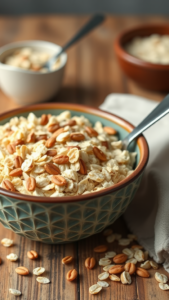Can You Eat Oatmeal on the Keto Diet? Evaluating Carbohydrate Content
When it comes to the keto diet, managing your carbohydrate intake is crucial. This high-fat, low-carb diet aims to shift your body into a state of ketosis, where it burns fat for fuel instead of glucose. So, you might be wondering: can you eat oatmeal on the keto diet? To understand this, let’s assess the carbohydrate content in oatmeal and how it fits into your nutritional goals.
Oatmeal is traditionally known as a healthy breakfast option, packed with nutrients. However, its carb content raises a red flag for those adhering to a keto lifestyle. A standard serving of cooked oatmeal, which is about one cup, contains approximately 27 grams of carbohydrates. If you’re following a strict keto diet, which typically limits daily carb intake to around 20-50 grams, this can consume a significant portion of your allowance.
Understanding Carbohydrates in Oatmeal
To evaluate oatmeal’s keto-friendliness, we need to break down its carbohydrate types:
- Net Carbs: This is the total carbohydrate count minus fiber. Fiber is not digested and doesn’t raise blood sugar levels, so it’s often excluded from your carb count.
- Glycemic Index: Foods with a lower glycemic index are less likely to spike your blood sugar. Oatmeal has a medium glycemic index, meaning it can elevate blood sugar more than other low-carb foods.
In general, a standard serving of oatmeal may have:
| Nutritional Component | Amount per 1 cup (cooked) |
|---|---|
| Carbohydrates | 27g |
| Fiber | 4g |
| Net Carbs | 23g |
| Protein | 6g |
| Fat | 3g |
From this perspective, you can see that while oatmeal offers some health benefits, its carbohydrate content makes it challenging to fit seamlessly into the keto diet. If you consume a portion, it can take away valuable carb allowances that could be used for other more keto-compliant foods.
Alternatives to Oatmeal
If you’re craving a warm breakfast bowl similar to oatmeal but want to stay within your daily carb limits, consider these alternatives:
- Chia Seed Pudding: With minimal carbs and high fiber, chia seeds can be soaked in almond milk for a delightful morning meal.
- Flaxseed Meal: Flaxseed porridge, made with hot water or nut milk, provides fiber and essential fatty acids with very low carbs.
- Almond Flour Porridge: A mix of almond flour, unsweetened cocoa powder, and a low-carb sweetener can create a fulfilling breakfast option.
- Egg-Based Dishes: Scrambled eggs or omelets using vegetables can also make a great low-carb breakfast choice.
Can You Eat Oatmeal on Keto? The Verdict
Ultimately, whether you can eat oatmeal on the keto diet comes down to your personal carb limits and how strict you want to be with your diet. Some individuals may choose to indulge occasionally, while others may prefer to skip it entirely to maintain ketosis.
If you decide to include oatmeal, be mindful of the portion size. You might consider having a smaller portion, perhaps half a cup, to reduce carb intake. Pairing it with healthy fats, like almond butter or coconut oil, can help mitigate blood sugar spikes and provide a more balanced meal.
It’s crucial to listen to your body and track how different foods make you feel, keeping an eye on your daily carb count. Everyone’s journey on keto is unique, so what works for one person may not work for another. Keep experimenting and adjust according to your goals.
While oatmeal isn’t typically considered keto-friendly due to its high carb content, you can still enjoy it occasionally with careful planning and portion control. Focus on whole, nutrient-dense foods, and prioritize options that support your keto lifestyle.
Alternative Breakfast Options for a Keto Lifestyle
For those exploring a ketogenic lifestyle, finding breakfast options that align with low-carb guidelines can feel challenging. Traditional staples like cereals and toast are generally off the table, but fear not! There are plenty of delicious and satisfying breakfast alternatives that fit perfectly into a keto diet.
Egg-Based Breakfasts
Eggs are a powerhouse of nutrition and an ideal choice for breakfast while following a keto diet. They are low in carbohydrates and high in protein and healthy fats. Here are some tasty options:
- Scrambled Eggs: Mix in some cheese, spinach, or avocado for extra flavor and nutrients.
- Egg Muffins: Prepare these in advance by whisking eggs with veggies and cheese, then baking them in muffin tins.
- Shakshuka: This North African dish features poached eggs in a spicy tomato sauce—great for a filling and savory breakfast.
Low-Carb Smoothies
Smoothies can be a quick and convenient way to enjoy breakfast on the go. To keep these keto-friendly, focus on low-carb ingredients. Here’s how to craft a perfect keto smoothie:
- Base: Use unsweetened almond milk or coconut milk.
- Add-Ins: Include leafy greens like spinach or kale, and opt for low-carb fruits such as berries in moderation.
- Protein: Consider adding protein powder, Greek yogurt, or cottage cheese to enhance nutritional value.
Breakfast Bowls
Breakfast bowls offer endless possibilities and a chance to mix and match ingredients according to your taste. Here are some ideas to get you started:
- Cauliflower Rice Bowl: Sauté riced cauliflower with olive oil and top with poached eggs and avocado.
- Chia Seed Pudding: Combine chia seeds with coconut milk overnight for a delicious pudding. Add nuts or seeds for added texture.
- Greek Yogurt Bowl: Use full-fat Greek yogurt and top it with a sprinkle of nuts and seeds, plus a few berries.
Nut-Based Breakfasts
Nuts and seeds are excellent sources of healthy fats, perfect for a keto-friendly breakfast. Consider these options:
- Nut Butter with Celery: Spread almond or peanut butter on celery sticks for a crunchy, satisfying snack.
- Flaxseed Meal Porridge: Combine flaxseed meal with coconut milk and heat it up for a warm breakfast alternative.
- Nut Protein Bars: Make homemade protein bars using nuts, seeds, and sugar-free sweeteners for a grab-and-go option.
Creative Pancakes and Waffles
Your beloved breakfast classics can be adapted to suit your keto diet. Here are some ways to achieve pancake and waffle bliss:
- Almond Flour Pancakes: Replace regular flour with almond flour for deliciously fluffy pancakes.
- Chaffle Waffles: Made from cheese and eggs, chaffles are a low-carb alternative to traditional waffles and can be sweet or savory.
A Sample Keto Breakfast Menu
| Day | Breakfast Option |
|---|---|
| Monday | Scrambled eggs with cheese and spinach |
| Tuesday | Chia seed pudding topped with nuts |
| Wednesday | Cauliflower rice bowl with avocado |
| Thursday | Almond flour pancakes with sugar-free syrup |
| Friday | Shakshuka |
Following a ketogenic diet does not mean sacrificing delicious breakfasts. By incorporating eggs, low-carb smoothies, creative pancakes, and nutrient-dense bowls, you can enjoy satisfying and nutritious morning meals. Explore these varied options, and feel empowered to mix and match ingredients that excite your taste buds while keeping your carb intake low.
Remember, meal prep can be your best friend. Preparing ingredients in advance or planning your week’s breakfast can simplify your mornings and help you stick to your keto goals without feeling deprived.
The Impact of Fiber: Oatmeal vs. Keto-Friendly Foods
When considering nutritional choices, fiber plays a vital role in overall health. Many people enjoy oatmeal as a fiber-rich breakfast option. However, if you’re following a keto diet, you may find yourself questioning whether oatmeal is a suitable choice. To better understand this, it’s essential to compare oatmeal with keto-friendly foods in terms of fiber content and overall nutrition.
Oatmeal is a whole grain that is high in soluble fiber, which can help lower cholesterol levels and improve gut health. On the other hand, the ketogenic diet emphasizes low-carb and high-fat foods, often focusing on non-grain sources of fiber. Below is a comparison of fiber sources between oatmeal and some keto-friendly foods:
| Food Item | Serving Size | Fiber Content (grams) | Net Carbs (grams) |
|---|---|---|---|
| Oatmeal (cooked) | 1 cup | 4 grams | 27 grams |
| Chia Seeds | 2 tablespoons | 10 grams | 2 grams |
| Flaxseeds | 2 tablespoons | 6 grams | 0 grams |
| Avocado | 1 medium | 10 grams | 12 grams |
| Broccoli (cooked) | 1 cup | 5 grams | 6 grams |
From this table, you can see that oatmeal provides a decent amount of fiber but also carries a high net carb count. For those on a keto diet, the primary focus is to minimize carb intake to promote ketosis, where the body uses fats as its main energy source.
In contrast, foods like chia seeds and flaxseeds offer a high fiber content with significantly lower net carbs. such foods into your diet can help you reach your fiber goals while keeping carb intake low, aligning with keto diet principles.
When evaluating oatmeal in the context of the keto diet, it’s crucial to consider the overall carbohydrate content. Consuming a single serving of oatmeal can take up a significant portion of your daily carb allowance, which is usually restricted to about 20-50 grams on a standard keto diet. This is particularly important for those who are just starting the keto journey. If you indulge in oatmeal, it could hinder your progress toward ketosis.
Another aspect to consider is the type of fiber found in oatmeal. While oatmeal is rich in soluble fiber, keto-friendly foods often include insoluble fiber, which is excellent for digestion and helps maintain bowel regularity. Foods such as leafy greens, nuts, and seeds can provide this type of fiber while adhering to keto guidelines. Here’s a brief list of keto-friendly fiber sources:
- Avocado
- Olives
- Leafy greens (spinach, kale)
- Brussels sprouts
- Green beans
- Coconut (shredded, unsweetened)
These foods can improve your fiber intake without compromising your low-carb goals. It’s essential to strategize your meals to include diverse fiber sources that fit within the keto framework. This will ensure you not only meet your fiber needs but also support overall health, digestion, and well-being.
To summarize, while oatmeal can be an appealing and nutritious option for many, its high carb content may not align with the goals of a keto diet. Instead, consider exploring a variety of keto-friendly foods that are rich in fiber and low in carbohydrates. This balanced approach will provide you with effective support in your dietary goals while maintaining the health benefits that fiber brings.
How to Modify Oatmeal Recipes for a Low-Carb Diet
Are you looking to enjoy oatmeal while on a low-carb diet? It’s possible to modify traditional oatmeal recipes to fit your dietary needs without sacrificing flavor or texture. Here are several strategies to transform your oatmeal experience while keeping the carb count low.
Choose Low-Carb Oat Alternatives
Regular rolled oats are high in carbohydrates, so replacing them with low-carb alternatives is crucial. Here are some options:
- Chia Seeds: High in fiber, chia seeds swell in liquid, creating a creamy texture.
- Flaxseeds: Ground flaxseeds can mimic the texture of oats. Rich in omega-3 fatty acids, they are a great addition.
- Hemp Hearts: These add a nutty flavor and are packed with protein.
- Coconut Flour: This flour is low in carbs and can be mixed with water or nut milk to achieve a porridge-like consistency.
Incorporate Nut Milk
Instead of using water for your oatmeal base, opt for unsweetened nut milk such as almond or coconut milk. These nut milks contain fewer carbs than traditional dairy milk and add a creamy consistency to your dish.
Spice It Up with Flavorings
Adding flavorings can elevate your oatmeal dish without adding carbs. Consider these options:
- Cinnamon: A warm spice that aids in metabolism and adds a sweet flavor without sugar.
- Vanilla Extract: A few drops can enhance the flavor profile of your oatmeal.
- Nutmeg: This spice contributes a unique taste and is low in carbs.
Add Healthy Fats
Healthy fats can provide satiety and enhance the nutritional value of your modified oatmeal. Here are some fats you can include:
- Nut Butters: Almond or peanut butter can make oatmeal creamy and delicious.
- Coconut Oil: Adding a teaspoon can add flavor and healthy fats.
- Butter or Ghee: These fats can give a rich taste and are excellent in low-carb diets.
Boost with Low-Carb Toppings
Top your modified oatmeal with these low-carb options for extra flavor and nutrition:
- Berries: Raspberries and blackberries are lower in carbs compared to other fruits.
- Seeds: Sprinkle pumpkin seeds or sunflower seeds for added texture and nutrition.
- Unsweetened Shredded Coconut: This can lend a chewy texture and tropical flavor.
Sample Low-Carb Oatmeal Recipe
| Ingredient | Quantity |
|---|---|
| Chia Seeds | 3 tbsp |
| Unsweetened Almond Milk | 1 cup |
| Cinnamon | 1 tsp |
| Nut Butter | 1 tbsp |
| Fresh Berries (optional) | 1/4 cup |
Combine the chia seeds and almond milk in a saucepan. Cook on medium heat until thickened, stirring occasionally. Add cinnamon and nut butter for flavor. Top with fresh berries if desired.
Mind the Sweeteners
If you crave a bit of sweetness, opt for low-carb sweeteners like:
- Stevia: This natural sweetener has no carbs and won’t spike blood sugar levels.
- Erythritol: A sugar alcohol with very few calories and carbs.
- Monk Fruit Sweetener: A natural, zero-calorie sweetener with low glycemic impact.
By utilizing these modifications, you can enjoy the comforting experience of oatmeal while sticking to your low-carb lifestyle. Experiment with flavors and ingredients to find the perfect balance that suits your taste buds.
Understanding the Chemistry of Ketosis and Food Choices
Ketosis is a metabolic state in which your body shifts from using glucose for energy to utilizing fat stores. This process is at the heart of the ketogenic diet, which emphasizes low carbohydrate intake and high fat consumption. Understanding the chemistry of ketosis can help you make informed food choices to support this process effectively.
When you consume very few carbohydrates, your body experiences a reduction in insulin levels. Insulin is a hormone that regulates blood sugar levels and facilitates glucose uptake. With lower insulin levels, your body begins to break down stored fat into fatty acids and glycerol. This breakdown enters the liver, where it is converted into ketones. These ketones serve as an alternative energy source, providing fuel for the brain and body.
The chemistry of this transformation is complex, but it can be simplified into several key steps:
- Carbohydrate Restriction: In a standard diet, carbohydrates are your primary energy source. When you reduce carbohydrate intake, your body needs to find another energy source.
- Fat Mobilization: As carbohydrate stores diminish, your body starts mobilizing fat from adipose tissue.
- Ketone Production: The liver processes free fatty acids to create ketones, which can replace glucose as the primary energy source.
Food choices play a vital role in entering and maintaining ketosis. Focusing on high-fat, low-carb foods is crucial. Here’s a breakdown of food types that align with the ketogenic philosophy:
| Food Category | Examples |
|---|---|
| Healthy Fats | Olive oil, avocado oil, coconut oil, butter, nuts, and seeds |
| Proteins | Fatty fish (like salmon), poultry, beef, eggs, and full-fat dairy |
| Low-Carb Vegetables | Leafy greens, broccoli, cauliflower, zucchini, and bell peppers |
| Avoid | Breads, pasta, rice, sugary foods, and high-carb fruits |
One of the most challenging aspects of following a ketogenic diet is avoiding hidden carbohydrates in foods. Many processed items, even those that seem healthy, can contain sugars or other high-carb ingredients. It’s essential to read labels diligently.
Another crucial factor to consider is the importance of individual variation. Some people might enter ketosis more easily than others, depending on factors such as metabolism, activity level, and overall health. Testing ketone levels can provide feedback on how well your body is transitioning into ketosis.
- Blood Ketone Meters: These devices measure the level of ketones in the bloodstream.
- Urine Ketone Strips: A more accessible option, these provide a quick snapshot of ketone levels.
- Breath Meters: These test for acetone in your breath, another type of ketone.
Staying in ketosis is crucial for maximizing the benefits of a ketogenic lifestyle. Some strategies can help you maintain this state:
- Focus on Whole Foods: The less processed your food, the easier it is to control carbohydrate intake.
- Meal Planning: Preparing your meals ahead of time can help avoid high-carb temptations.
- Regular Monitoring: Keep track of your ketone levels to ensure you remain in ketosis.
As you explore food choices within the framework of ketosis, remember that your body is unique. What works for one person may not work for another. Tailor your diet to your preferences while prioritizing low-carb, high-fat options. Finding enjoyment in your meals helps sustain the lifestyle long-term.
Understanding the chemistry of ketosis can empower you to make wise food choices. By focusing on whole, nutritious foods while minimizing carbohydrates, you can efficiently support your body in reaching and maintaining a state of ketosis. This metabolic shift can lead to various health benefits, including weight loss, increased energy levels, and improved mental clarity.
Conclusion
Considering the carbohydrate content, oatmeal is typically not a favorable option for those strictly following a keto diet. With its high carb count, a standard serving of oatmeal can quickly use up your daily carb allowance, potentially kicking you out of ketosis. Instead, exploring alternative breakfast options that align better with keto principles is essential. Foods like scrambled eggs, avocado, and chia pudding can provide the taste and satisfaction you crave while maintaining your dietary goals.
While oatmeal is rich in fiber, which is important for digestion and overall health, it’s crucial to choose fiber-rich foods that fit within keto parameters. Low-carb vegetables, nuts, and seeds offer similar benefits without the excess carbohydrates. Modifying traditional oatmeal recipes can provide a workaround; using options like flaxseed meal or almond flour may help create a grain-like experience without the carb overload. However, these modifications still require careful measurement to ensure you stay within your daily carb limit.
Understanding ketosis and how your body reacts to different food choices also plays a vital role in this dietary journey. It’s about making informed decisions that keep you in a state of fat-burning while still enjoying delicious meals. Remember, the journey is about finding a balance that works for you and allows you to enjoy eating while adhering to your keto lifestyle. Choose wisely, and your body will thank you!




